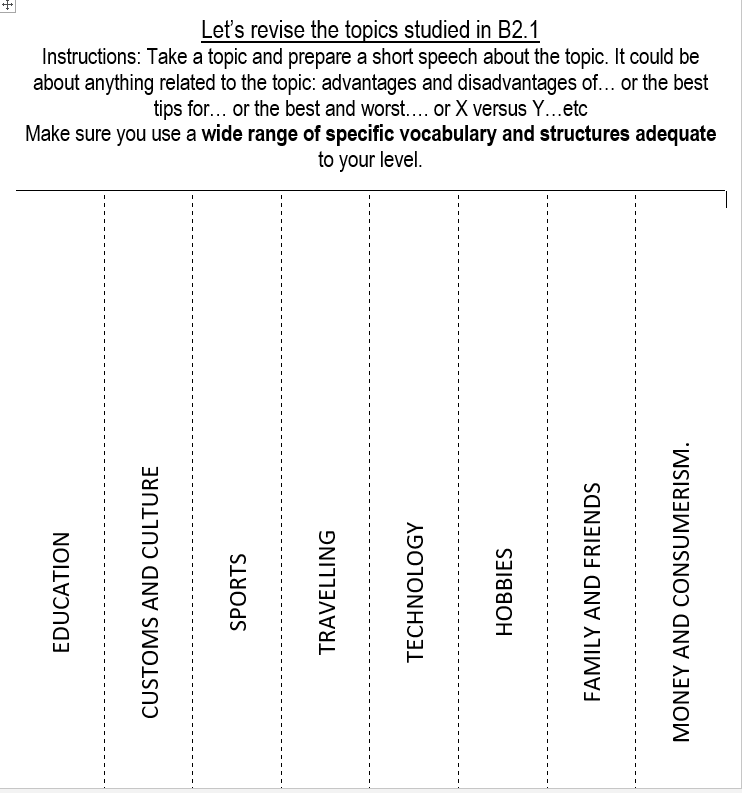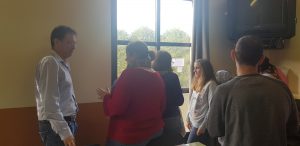Category Archives: Speaking
Messy Words: a Vocabulary, Writing and Speaking Activity
It is October and autumn has officially hit. I am just beginning to come to terms with the fact that days are getting shorter and warm days are saying their goodbyes. Well, welcome autumn! I am all here for you!
Let’s kick it off this new season with a vocabulary revision activity that aims at reinforcing vocabulary while at the same time providing an opportunity for students to stretch their legs and interact with other students in the classroom. Gallery-walks, my favourite!
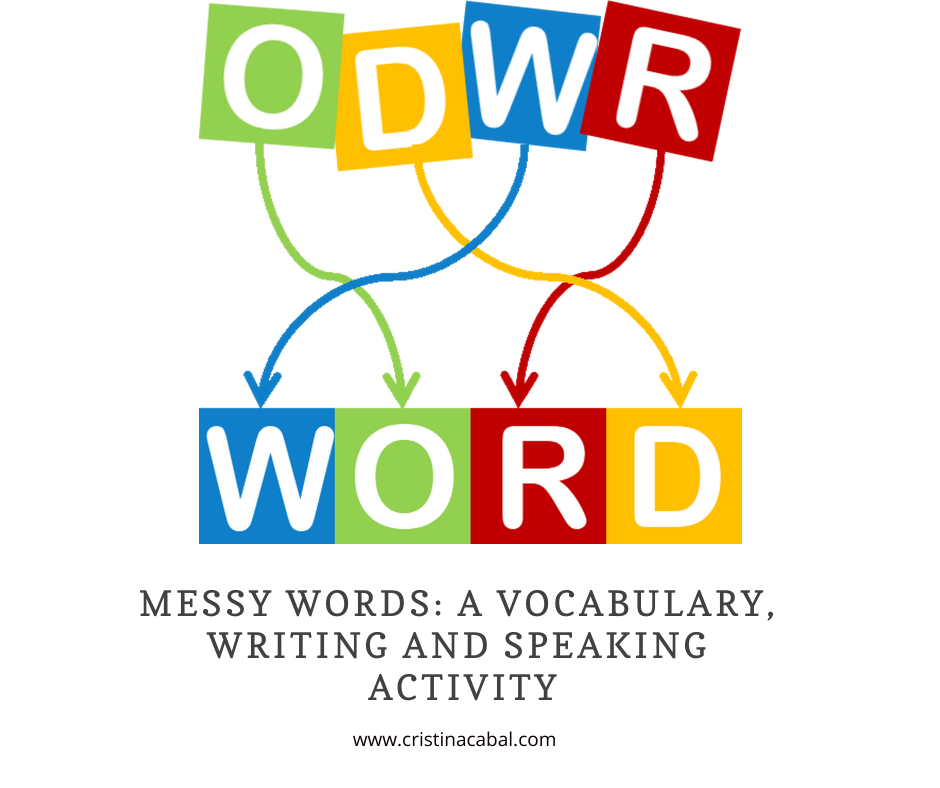
Aim:
- to reinforce the vocabulary of the lesson
- Use the vocabulary in context by
- writing an open-ended question containing the target word/expression
- answering the question by using the gallery-walk class dynamics
Procedure:
Before the class
- Choose a few words you want to revise. I suggest 8-10 words.
- Fold a regular sheet of paper horizontally and cut it in half. You will get two slips of paper. This is a good opportunity to recycle the back of spare photocopies from other courses.
- Write the letters of each word/expression you want to revise in random order. Number each of the slips of paper for easier reference.
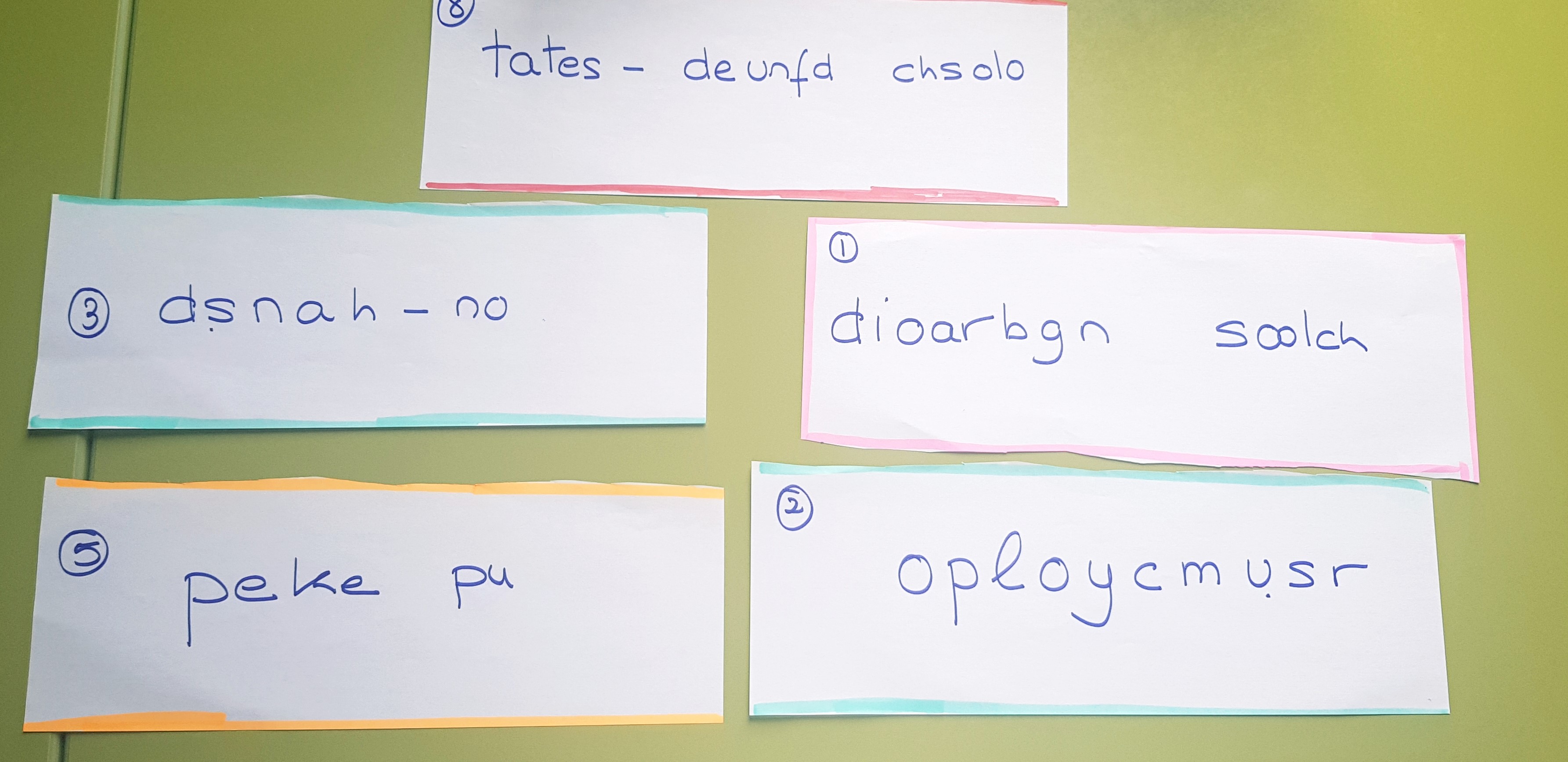
During the class:
Step 1. Slips of paper on the walls
Put up the slips of paper on the walls of the class and ask students in pairs or in threes to stand up and work out what the hidden word on each slip of paper is. Ask them to number them as displayed on the walls. The first pair to have all the words, rings the bell (needless to say, there should be one on my table) and the rest of the class has one extra minute to finish this part.
Ask students to sit down.
Step 2. Writing open-ended questions
- Students continue working in their pairs. Assign the pairs two of the words/expressions on the walls and ask them to write two open-ended questions –one per term– related to “education” (this is the topic this week) containing the word or expression.
For example, one of the words was “state-funded school” and one of the questions was “Would you send your children to a state-funded school? Why (not)?”
- Give them small cards to write their questions and, using sellotape, place them next to the term the question refers to. Ask them to write their names at the back of the card so that you know who has written the question and to give feedback.
- Quickly correct the questions on the walls, and if there is more than one per word, choose the best one, which will remain displayed together with the slip containing the word in random order. Give the discarded questions back to their owners and allow them some time to focus on their possible mistakes.
Step 3. Speaking. Gallery walks
With the words and the questions displayed on the walls, ask students in pairs to stand up and choose a station (slip+card).
Instruct them to answer the question elaborating on the answer. Allow 5 minutes/station and then ask them to move clockwise to the next station. Repeat procedure.
Until next post! 🙂
Flexible Seating Using Collocations
What could be the advantages of sitting always in the same place working with the same partner? Can you see any? I can’t. The activity below has been designed to give students plenty of opportunities to work with different partners in an engaging way. It is very flexible and lots of fun.
But first of all, a small intro. It is my first post in a long, long time so please bear with me. 😉
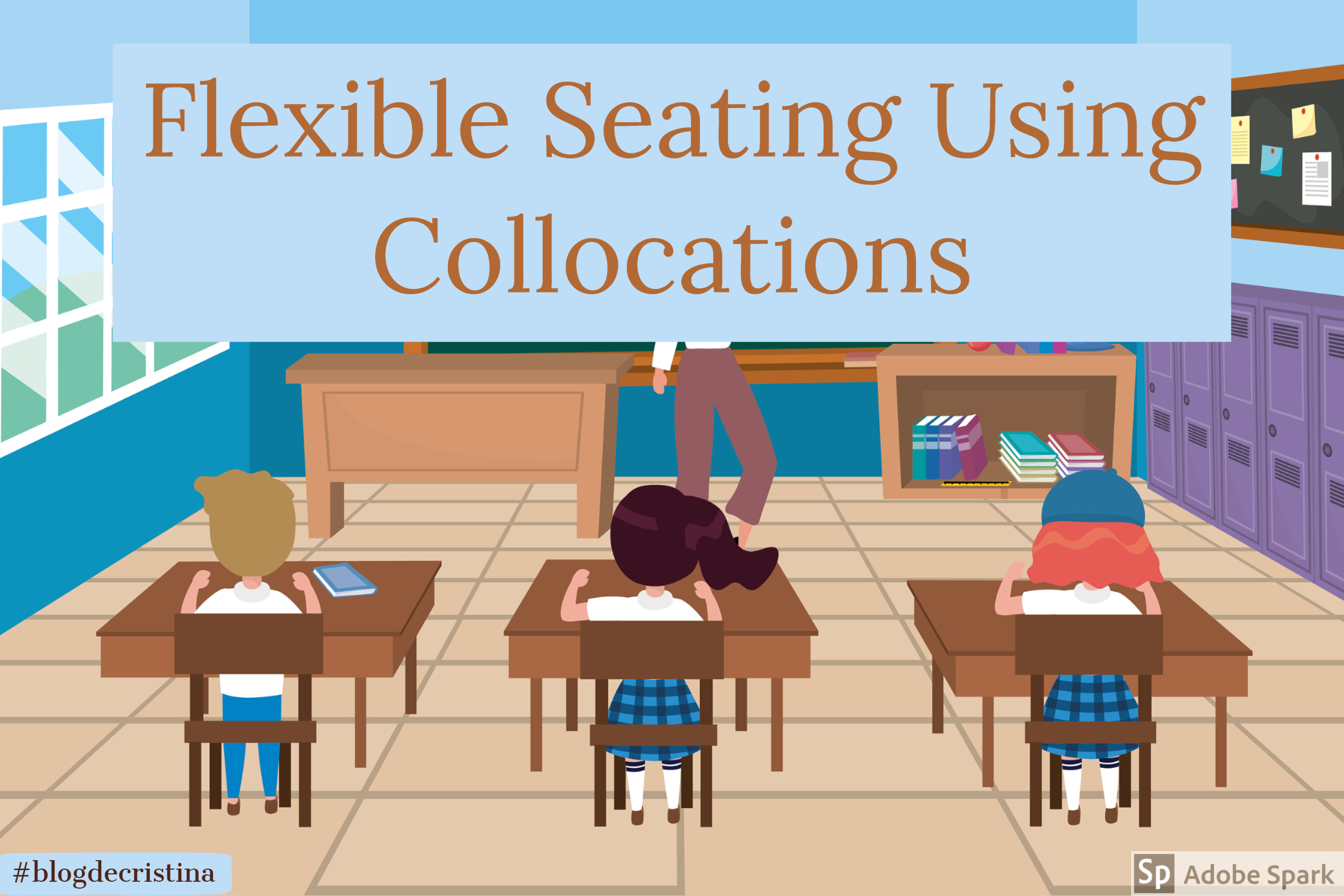
It is October!
If you are wondering, no, we haven’t started classes yet. I’ll be greeting my new students tomorrow, 7th October. I can’t wait! I already know my classes are full. 25 students and some more on a waiting list. I am a bit worried because my class is tiny. One of the smallest in the premises but hey! I am not sharing it with any other teachers. It’s just for me, so I am not complaining. However, I like to do activities where students get up from their seats and move around the class and that’s going to prove difficult in this smallish class. I guess I will just need to use the hall for some activities.
Isn’t it true that we spend most of our day at school or work sitting down? And after some time, sitting down gets boring, doesn’t it? Well, in this activity students will need to stand up, move around the class and then sit down several times. Just my kind of activity. Besides, it can be adapted flexibly and creatively in different contexts and situations. At the end of the post, you can read some other ideas I have to teach or revise vocabulary using this classroom dynamics.
Aim
- to revise very common collocations
- to ask and give information about yourself
- to provide opportunities to get to know everybody in the class
- to provide a friendly environment where students do not feel uncomfortable making mistakes and can learn from each other.
Time: 30-40 minutes
Preparation:
- The collocations. Prepare a set of common collocations. You will need one per student. I have 25 students, so I will need 25 collocations. For example: break the law or fail an exam. On a card, write break or fail; on another card write the law or an exam. The cards containing the second part of the collocation (the law, an exam) should be sellotaped to the back of the chairs of the classroom, visible to all the students. I use different colours for easy differentiation. (see picture below)
- NOTE: it is important that the collocations are unique, ie, that they can only match once. For example: if you have break //the law, you cannot have twist //your arm; as break can also collocate with arm as in break//your arm. It is useful to keep a list of the collocations you are using for agility purposes.
- The questions to discuss. Prepare a set of questions; in my case, and for this class, of the type get-to-know-each-other questions. I have prepared 25 but you can easily just use half the questions and have students share and talk about the same card.
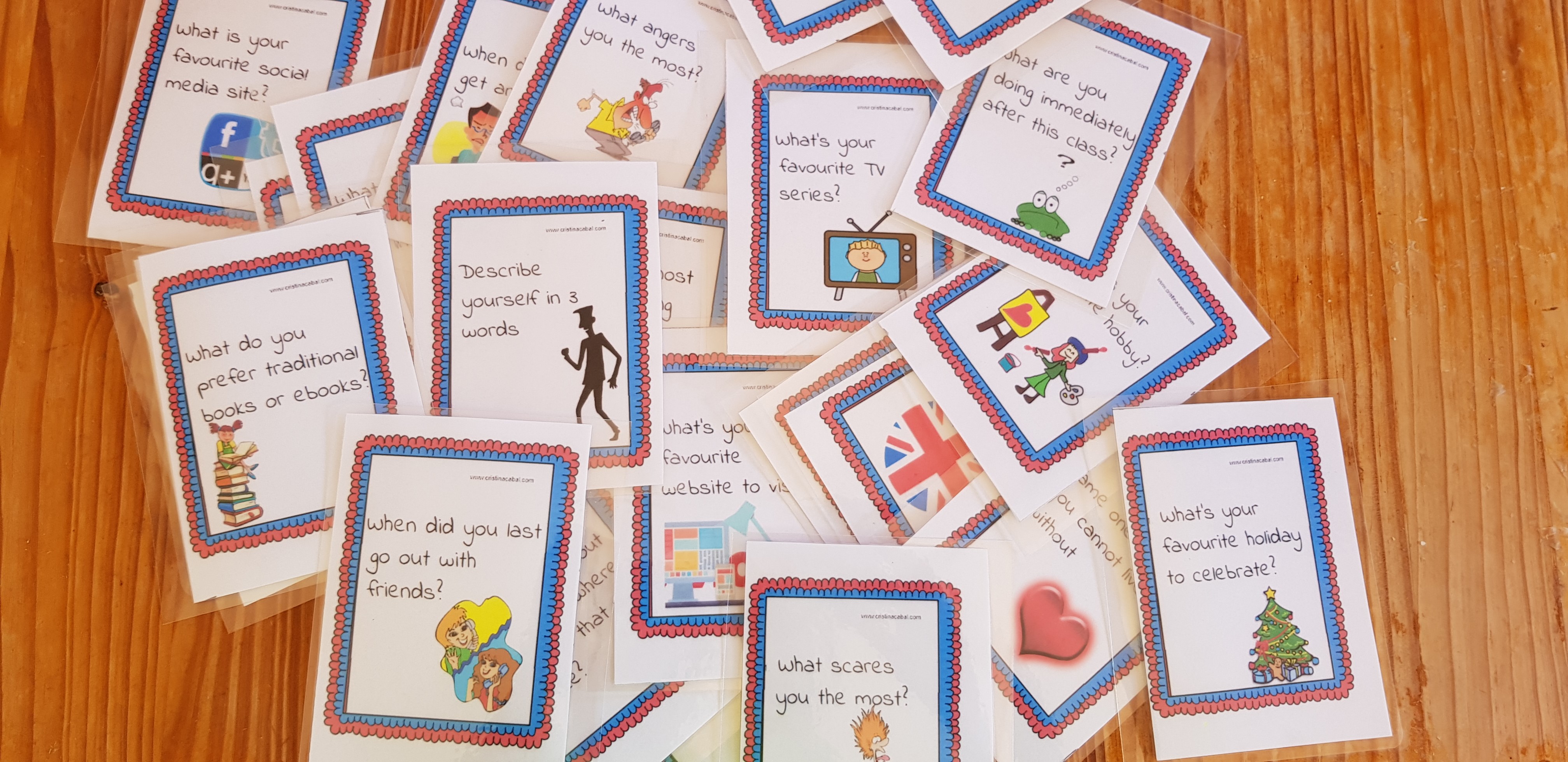
Downloadable Materials:
Procedure:
- Greet students at the door and hand them a card containing the first part of the collocation.
- Explain that they will have to find the second part by reading the cards taped on the chairs.
- Once they have found the matching card on a chair, they should sit down on that same chair.
- Quickly check that everybody has found the right collocation and if they haven’t, ask students to work out where the matching part is before you intervene. It is good to make mistakes. That’s very often how you learn.
- Ask them to say their collocation aloud so that the class can also revise it.
- Once they are in their right seats, hand them a card containing a get-to-know-you question. Encourage them to include their collocation in their conversations.
- Ask them to leave the cards containing the get-to-know-you questions on the table. They can remain there for the next students.
- Allow 6-7 minutes’ conversation and then collect the cards containing the first part of the collocation. (in the picture below, the pink ones)
- Shuffle them, hand them out to different students and repeat procedure so that students get the chance to sit in another place and talk to a different student.
- This second time, when students say their collocations aloud, ask them to pause for a second to give the class the chance to provide the second part of the collocation. This way, we reinforce without effort.
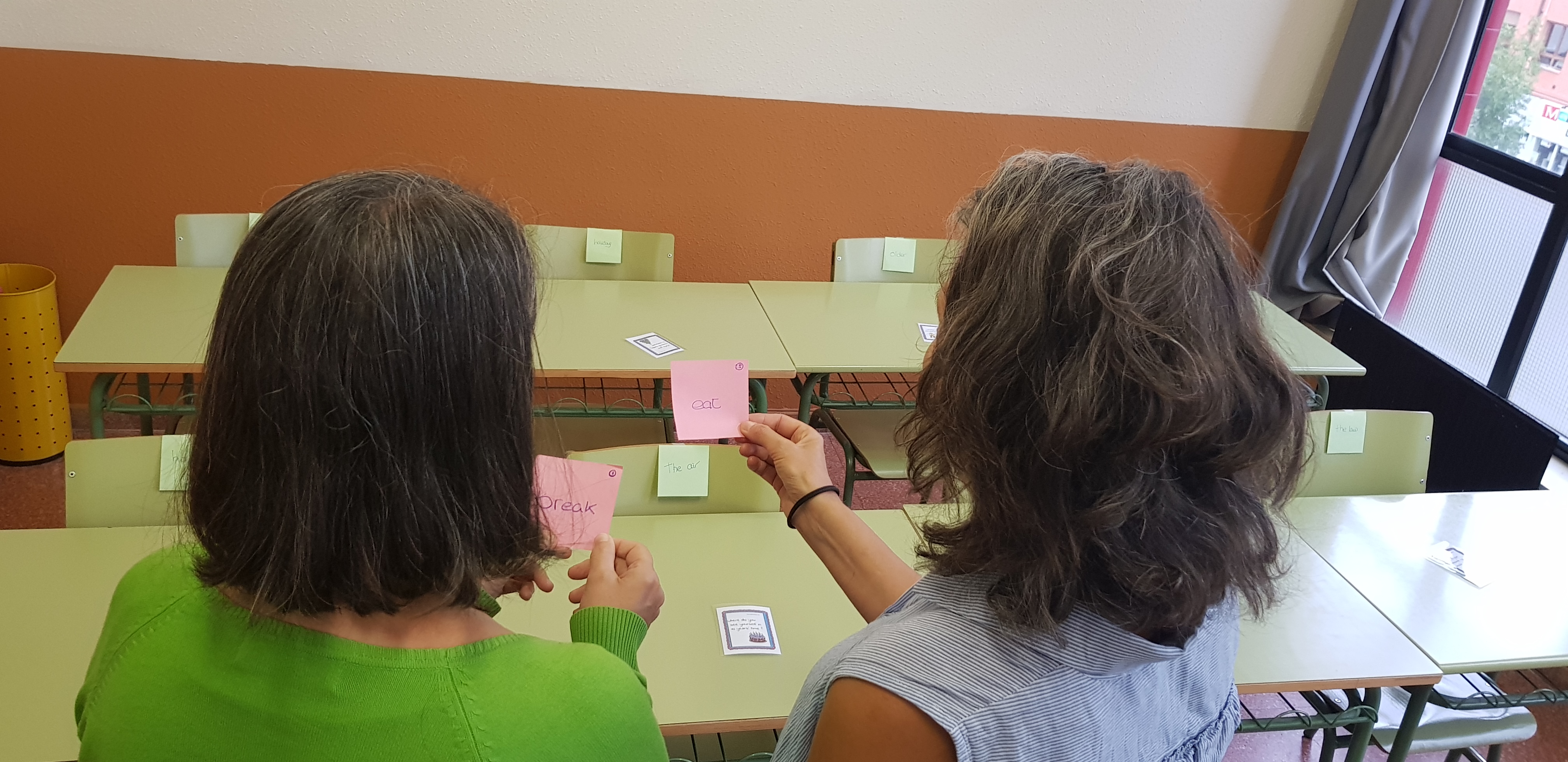
TIPS:
- I did the activity 4 times. The first time students found it harder to find the right collocation than the second time; the third and fourth time, they were incredibly quick.
- I asked students to focus on their cards and read them carefully. Sometimes, the key to finding the right collocation resides in an article or a preposition.
- The first and second time, and always before the speaking activity, I asked students to read their collocations aloud so that everybody got familiar with them. The third time, I asked them to try to remember their collocation without looking at the back of the chair. The fourth time, I asked students to read aloud just the first part and then pause, giving the class the opportunity to provide the matching collocation. Revising, reinforcing and consolidating. That’s what we are aiming for.
- At the end of the activity, I asked students to write down all the collocations they could remember and wrote them on the board to correct spelling mistakes. I gave a sweet to the student who remembered the most collocations 🙂
VARIATIONS
- Working with the vocabulary of a certain topic; on the chairs sellotape the cards containing the term and give students the cards containing the definition. For example, if I am teaching Education: on one card professor (taped on the chair) and on the other card a senior teacher at a university or college; and on the table a question such as: What was your favourite subject at school?
- Working with phrasal verbs: term//definition
- Working with compound nouns: first half// second half. For example: sitting// room
- Working with phonemic transcriptions; on one card the phonemic transcription; on the chair the card with the matching word /si:n/ seen
- Working with functional language; on one card the function in the form of a question and on the chair, a card with a possible answer. The follow-up task might be to continue the dialogue.
I don’t know. So many possibilities. The limit is your imagination.
Desk Rotation: A Great Activity to Activate Vocabulary from Different Topics
Jennifer Gonzalez from Cult of Pedagogy once wrote: “Just because you covered it, that doesn’t mean they learned it”. This seems to be true here in Spain, and overseas. We are all in the same boat, apparently and unfortunately.
This activity is super simple and it’s loaded with effective learning as students take an active role during the whole activity. Besides, it’s the kind of activity that I like as it gets students out of their seat and moving.
Ingredients:
Collaboration+ movement+ vocabulary+ speaking + grass skirts + fun= effective learning

Aim:
- to revise and activate vocabulary related to different topics
- to use this vocabulary in a speaking activity
- to spice up learning
Before the class:
- Arrange the room so that the tables form stations.
- Decide on the topics you want to revise and write each of them on a different slip of paper. Stick each slip of paper on a different table ( station). You can use with sellotape or blue-tack.
- Using a grass skirt poster, write down an open question for each of the topics you want to revise. Here’s the template, kindly provided by Tekhnologic
- Cut a line between words but don’t cut them all the way so that the slip of paper doesn’t detach.
- You will need one poster per group. I print them in different colours for easy differentiation
Step 1. Working with Vocabulary
- Divide the class into small groups as many as topics you want to revise. For example: if you want to revise: sports, education, environment, travelling and technology, you will need to form 5 groups.
- Arrange the room so that the tables form stations.
- Assign one topic per table/station.
- On the table, place a sheet of paper and write “Vocabulary” on it
- Assign each group to each of the stations you have set up in the room.
- Instruct them to write down on the sheet of paper provided vocabulary related to the topic and adequate to the level. If it’s a B2 level and the topic is Travelling, words such as “suitcase” or ” plane” would not be appropriate. Allow the 2″30′ for this part.
- When the time is up, ask them to rotate to the next station.
- Ask them to read the vocabulary other students have written so as not to have the same words and ask them to add new ones.
- Continue until all the groups have covered all the stations.
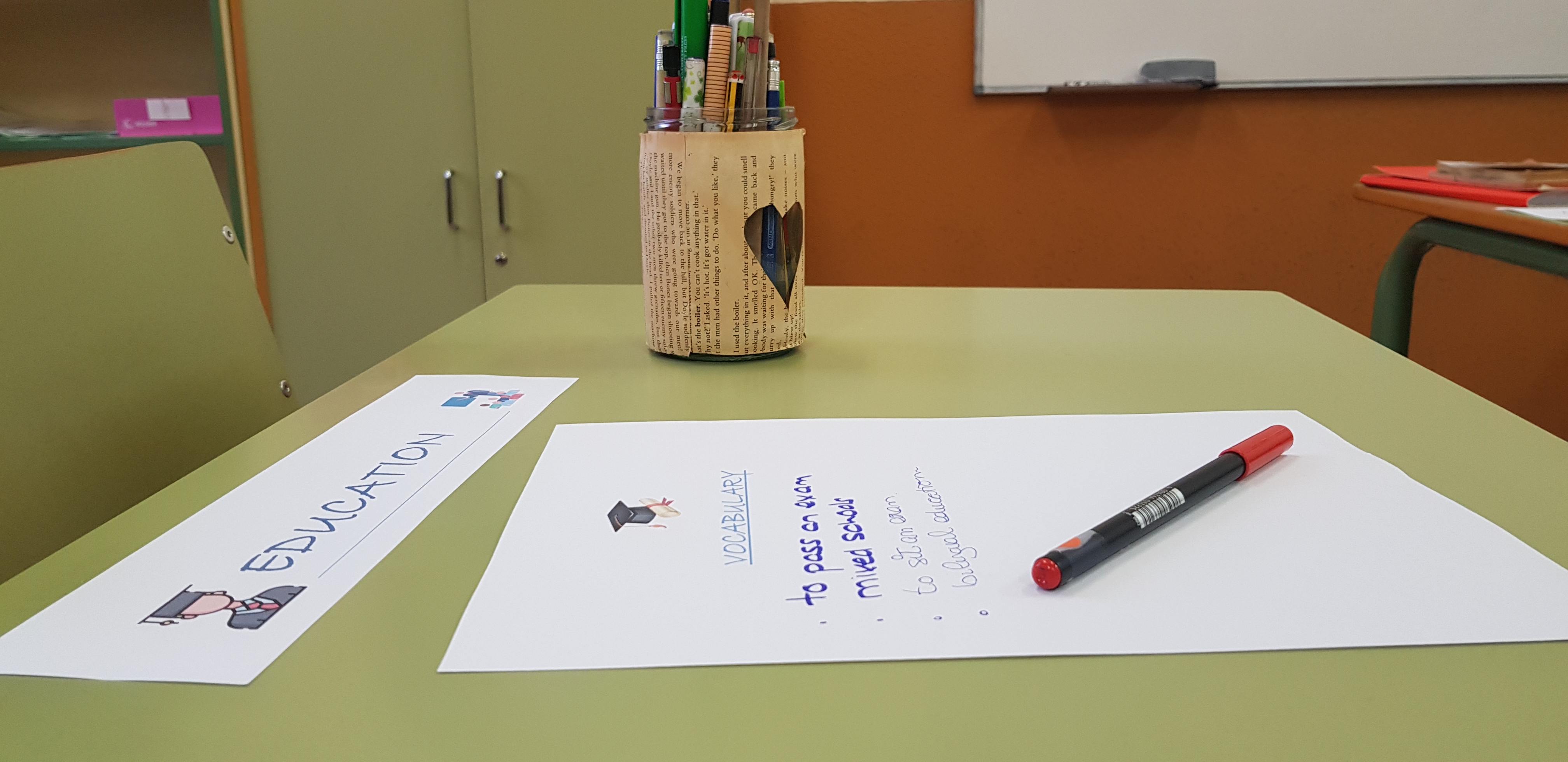
USING THE VOCABULARY IN A SPEAKING ACTIVITY: GRASS SKIRTS. 
I know. Again. Grass skirts are quickly becoming my favourite non-tech tool.
- Put the poster(s) on the walls of the class and assign a poster to each group.
- As students rotate to the different stations, they tear off the corresponding question form their poster. They can only do it from their assigned poster.
- Before they start talking, ask them to read through the list of related vocabulary they have all contributed to.
- Give students about 3 or 4 minutes to discuss the question. Encourage the use of vocabulary.
- Give each group a different coloured pen and ask them to put a tick next to the words they have used. Allow 1 minute for this part.
- Ask them to rotate to the next station and repeat procedure.
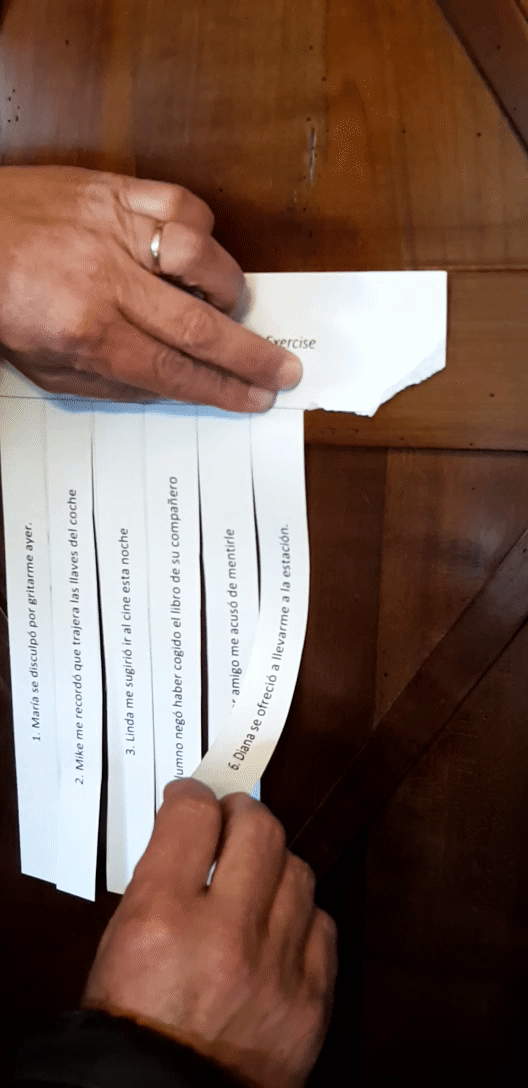
Using Grass Skirts to Revise Topics
This is a very quick post to share with you an idea I had this very same morning to “ask” my students to start revising for oral exams.
Where I teach, the B2 level is divided into two courses: B2.1 and B2.2. To be perfectly honest, sometimes I wish there was a B2.3 course. I always feel like I need more time to prepare them to take the dreaded standardized exams they need to sit at the end of each level.

Anyway, the idea is to politely “force” my students to start revising the topics and obviously the specific topic-related vocabulary studied in B2.1. However, some of my students are really hard-working and they have already started revising on their own. For this reason, I don’t want to schedule the revision, I want them to choose the topics they really need to revise. Worried about the best way to do it, I came up with this idea. I haven’t tested it yet, but I hope it is effective.
TEARABLE TOPICS
First Day. Preparation:
- Choose a number of topics and write them down. You can use my own template. See it here. You can make your own template o download the one Tekhnologic very kindly offers on his website. I have used his.
- Cut a line between words but don’t cut them all the way so that the slip of paper doesn’t detach.
- Each poster contains 8 topics. If you have between 10 and 18 students, you will need two copies of the poster. I printed them in different colours for easy differentiation.
- Put the poster(s) on the walls of the class.
- Divide the class into two groups and assign a poster to each group.
- Tell students they will have to choose the topic they would like to revise and tear off the piece of paper containing the topic they have chosen. They can only do it from their assigned poster.
- Homework: tell students that they will need to prepare a speech of about 3 minutes about something related to their topic. Some ideas are suggested in the poster together with more detailed instructions.
Day 2.Procedure.
- Students within their groups form groups of 3 and give their speeches.
- Encourage members of the group to ask follow-up questions once the student has finished.
- Repeat procedure to continue revising: display new posters (with the same topics) on the walls of the class and again ask students to choose a new topic to be revised. Again, ask them to prepare a short speech for the next day and repeat procedure.
Click to get the editable document
